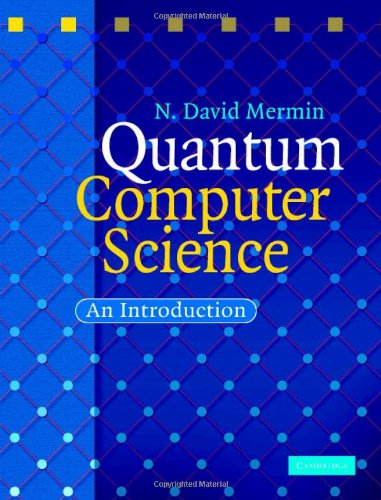1.2.1.Superposition: doing multiple things at once
A typical course on quantum mechanics introduces the need for
something beyond the classical world by discussing the double-slit
experiment. This famous experiment involves a single source emitting
individual particles or photons. Their path is blocked by a screen
with two slits, and behind that screen sits a detector.
Even though we can see particle-like behaviour of the quanta because
individual blobs appear on the detector one-by-one, the pattern that
emerges after a large number of quanta have been emitted is one of
interference.
Superposition means that quantum systems “compute”
multiple classical things at the same time.
What this shows is that quantum particles, in a way, go through both
slits
at once, and only the measurement at the detector forces
them to become classical again, giving a concrete outcome for the
position. The quantum world thus makes the particle do two things
at the same time, only collapsing onto a definite prediction
once the measurement is made. The state of the system, until the time
that the measurement is made, is one of a superposition of the
particle going through slit \(S_1\) and another one of the particle
going through slit \(S_2\).
Application of superposition: quantum algorithms and
quantum computing.
It is this “doing multiple things at once” aspect that underlies the
fact that quantum computers can do things “much faster” (in a sense
that will be made precise later in this course) than classical
computers. From this simple example it is also already clear that,
while quantum systems can do multiple classical things at once, the
tricky bit will be to somehow make use of that and extract all those
multiple “computations” at the end.
1.2.2.Entanglement: connection without interaction
Entanglement is often only discussed once spin systems are introduced
into quantum mechanics, but we have seen that entanglement really is a
property of the quantum world that already exists for simple
two-particle systems for which each particle is only labelled by a
position.
If the positions of the two particles are labelled by \(x_1\) and \(x_2\)
respectively, then the wave function is some complex-valued function
\(\psi(x_1,x_2)\) of these two variables. In the special case that the
function is separable, that is, when it takes the form
\begin{equation}
\psi(x_1, x_2) = \psi_1(x_1) \psi_2(x_2)\,,
\end{equation}
the system is
non-entangled. This means that a measurement of
the position of particle 2 does not influence the measurement of the
position of particle 1. If we do not measure particle 2, the
probability density for particle 1 is
\begin{equation}
P_1(x_1) = \int \big|\psi(x_1,x_2)\big|^2 {\rm d}x_2 = \big|\psi_1(x_1)\big|^2\,,
\end{equation}
because \(\psi_2(x_2)\) is itself normalised. If we first measure the
position of particle 2 to be \(x_2=q\), then the wave function collapses to
\begin{equation}
\tilde{\psi}(x_1) = N \psi(x_1, q) = N \psi_1(x_1) \psi_2(q) = \psi_1(x_1) \,,
\end{equation}
where the constant \(N\) is determined by imposing
that \(\tilde{\psi}(x_1)\) is normalised. Because the wave function was
separable, the probability density is the same as before, \(P_1(x_1) =
\big|\psi_1(x_1)\big|^2\). In terms of the picture above, the
measurement of particle 1 before we know anything about particle 2 is
obtained by integrating over the vertical direction, while measuring
particle 1 after we measure particle 2 is done by evaluating the
function at a particular vertical position. For a separable function,
these are equivalent.
However, when the wave function is not separable, these two
computations generally differ. For instance, assume that the wave
function is
\begin{equation}
\psi(x_1,x_2) = \psi_1(x_1)\psi_2(x_2) + \chi_1(x_1)\chi_2(x_2)
\end{equation}
for four different functions \(\psi_1, \psi_2, \chi_1,
\chi_2\). Integrating the complex norm-squared over \(x_2\) or inserting
a particular value \(x_2=q\) will now typically not produce the same
function of \(x_1\). In the picture on the right above, the difference
is clear:
integrating along the vertical direction \(x_2\) does
not produce the same function of \(x_1\) as
slicing the plot
along some horizontal line \(x_2=q\).
Entangled states lead to one particle influencing the
other even when there is no interaction, and even when the particles
are separated by an arbitrary distance.
So typically, the measurement of the position of particle 2
changes the subsequent probability distribution for the
measurement of the position of particle 1. This is what is known as
entanglement. The important aspect of this is that measuring
one particle immediately has consequences for the measurement of the
other particle, even though the particles do not interact and even
though the particles can be arbitrarily far separated. This never
happens in classical mechanics.
Applications of entanglement: secure communication and
quantum key distribution, teleportation, deciding whether nature is
fundamentally non-classical (“Bell inequalities”).
Entanglement
provides us with new ways to secure communication channels and also
allows us to “teleport” a quantum state to a different location
using classical communication. Moreover, it has played a crucial role
in deciding whether the probabilistic character of quantum mechanics
is merely due to “lack of understanding”, or whether it is something
fundamental. We will see that there are certain inequalities (the
“Bell inequalities”) which will tell us that nature is
not
classical.

